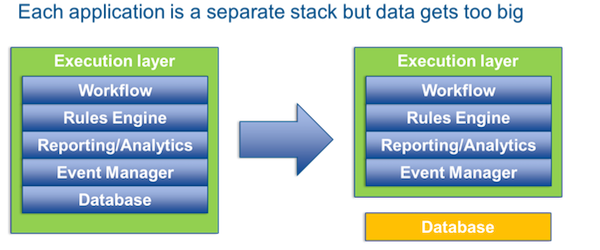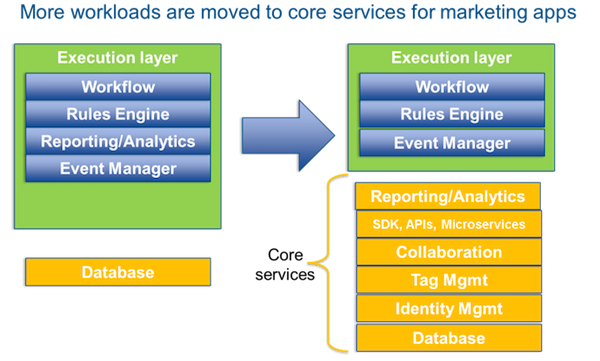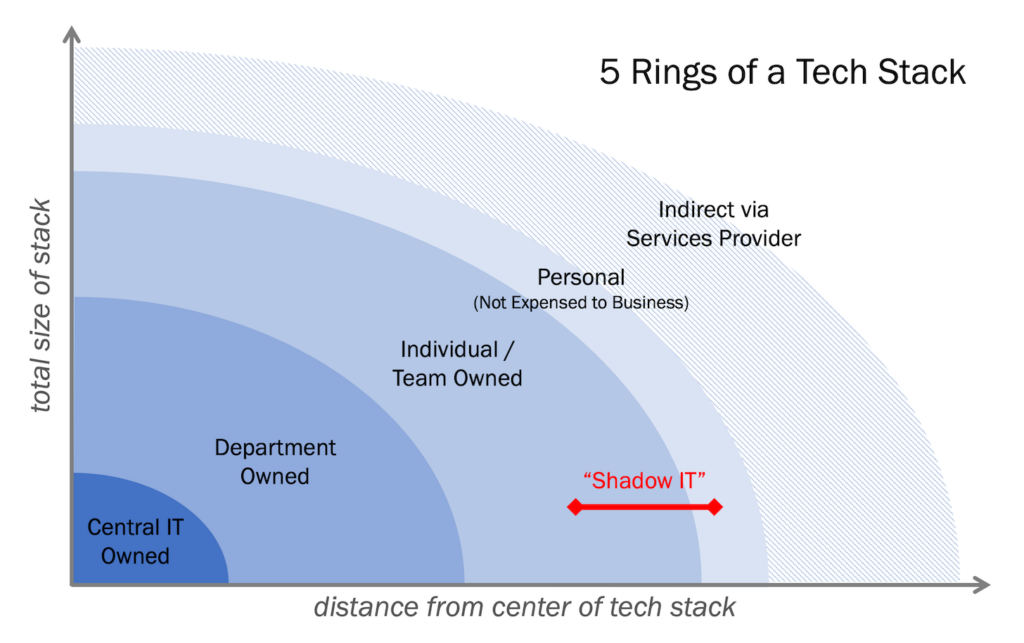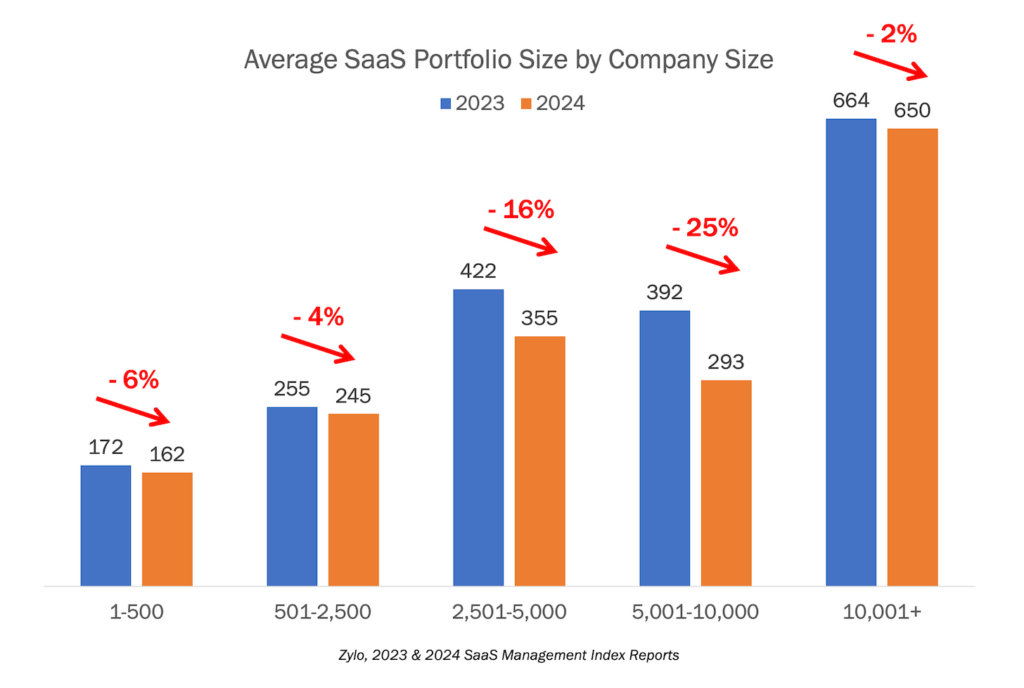The following is a guest post by Gerry Murray, research manager for IDC’s CMO Advisory service and a popular speaker at the MarTech conference. All images in this post are courtesy of IDC.
In the early days of the martech industry, every application had to be a standalone solution. In addition to the execution environment (email, web, social), they had to have all the underlying services for data, workflows, analytics, reporting, etc. Thus each was a fully functioning solution that could be bought and implemented separately.
But each was also a silo. As companies deployed multiple silos, the need to share customer data between them became obvious. So early users built marketing datamarts and warehouses. That was a good thing. But it left other critical information locked in the systems, making orchestration, attribution, and optimizing customer experience difficult if not impossible.
Once the conversation moves to customer experience, by definition it expands beyond marketing and becomes a holistic framework that requires a new approach, one acts as a central nervous system for the business.
The customer experience operating system (CX-OS) is an operating system in a business sense. Why give it such a clumsy name? Because it is not a “management system” or a “platform,” both of which connote a set of applications.
The CX-OS is a set of APIs, microservices, and glue code that connects the underlying processes companies use to communicate with customers and perform activities on their behalf. It is a low-latency, high-activation environment that delivers a growing set of software services to manage workflows, decisions, events, data, processes, audiences, customer IDs, security, etc.
With it, a customer that submits a support ticket a minute before an email blast goes out from marketing gets a message that reflects the interaction they just had with the call center.
It relieves the customer from having to constantly retell their story to the next person or system with which they interact. It helps each functional department (advertising, marketing, sales, digital commerce, finance, fulfillment, services, call center, etc.) enhance the performance of every other department.
The CX-OS is the next basis for competitive advantage because marketing is no longer about context and messaging, it’s about continuity and value. It will be obvious to customers which companies have a CX-OS and which ones do not.
The lack of a CX-OS is felt routinely in all customer-related functions, because each is generally unaware of what interactions have occurred in other departments. It is acutely felt by marketers, who not only struggle to bring data together from marketing channels such as online ads, social marketing, web forms, emails, etc., but also from internal sources such as sales pipeline, ecommerce transactions, and service interactions. LOB leaders are looking for something to facilitate the digital transformation of their entire business — not just the individual departments.
The CX-OS will evolve in a series of stages. Most enterprises are currently in the first or second stage.
Stage 1 is the Marketing Application Silo, which has separated the database from the execution layer, as shown in the figure below. For many small businesses, this is sufficient.
Stage 2 evolves to the Marketing Cloud, which further separates out distinct capabilities from marketing execution. Stages 1 and 2 align with existing departmental budgets, which makes these models easier for vendors to sell and customers adopt. For many mid-sized companies and those with smaller marketing operations, this is sufficient.
But for large enterprises with many lines of business, global markets, and diverse customers, the silo and cloud approaches and various flavors such as stack of stacks, etc., are not sufficient to support an end to end customer experience strategy.
In Stage 3, a modern, services-enabled infrastructure emerges that can manage and optimize all customer interactions. Without it, large enterprises will not be successful in delivering seamless experiences across the whole customer lifecycle — a lifecycle that is increasingly at risk as switching costs drop for both consumers and businesses.
In fact, IDC predicts that 50% of all digital transformation efforts will fail due to the absence of the CX-OS.
Of course, the CX-OS involves much more than is pictured, including: mobile, user management, security, compliance, approvals, calendaring, content taxonomies, etc., and will evolve to incorporate even more.
This is not to say that applications will lose all of this functionality. They will simply offload as much as possible. It is also not our intention to imply that single solutions will span the enterprise at each layer. There may be multiple engines at work, but they should be linked to for an end to end system for managing data flow throughout the enterprise.
This model should encompass all modern applications, including employee, production, partner, supply chain, etc. Otherwise, the risk is building another silo around customer data. For example, for functions such as user management and data governance, the CX-OS needs to fit into the enterprise environment, not provide its own version of them.
The goal is low latency between interactions, so that if a customer logs a support call a minute before a marketing blast goes out, they can either be excluded from the list or even better, the messaging can be dynamically pre-empted by something related to the call.
The Achilles’ Heels: Ownership and Budgeting
A contributory model should be created so all customer facing functions are able to benefit from and leverage the development of a CX-OS.
But spending and ownership at many companies are still stuck at the departmental level. That’s largely because budgeting processes have not changed to reflect the fact that these are horizontal efforts that cut across many functions and need to be supported as such.
Establishing a new C-level role like Chief Customer Officer is a waste unless each of these departments has skin in the game. CX is a collective effort, it does not lend itself well to command-and-control or committee models. There will need to be shared metrics to align behavior and determine ROI. Until that changes, archaic budgeting models will hamstring efforts to transform the business around the customer.






Great post. How does content – arguably an essential piece of the digital experience – fit into this model?
4 years later, and this concept is still really interesting! – Has there been written more about it since?